In last weeks parashah (Torah reading,) called Chayyei Sarah, Avraham Avinu (Abraham) comes to the city of Hebron and purchases the cave of the Machpelah as a burial ground. It is said that Avraham smelled the scent of Gan Eden (the garden of eden) eminating from the cave. Indeed, the very word Hebron is rooted in Chet-Bet-Resh, Chibur, or connection, as Hebron is seen as the connection between this world and the next.
Parashat Chayyei Sarah has become a day of pilgrimage to Hebron and the surrounding settlements. The community of 7,000 Jews swells to at least 25,000 as religious pilgrims flood in from every corner of Israel and the world.
As for me, I received a phonecall from Sasha, my friend from Elon Moreh, letting me know that he had a spot for us at a friend's house in Harsina, one of the settlements surrounding Hebron. After spending my Friday morning picking fruit with Project Leket, I asked the bus driver to dump me near the central bus station, and was off to meet Sasha.
I'd never seen the central bus station so crowded. Throngs of people tried to cram themselves through the metal detectors, with the usual yelling and bickering. Eventually, I got through and followed the stream of travellers heading for the third floor, departures.
After some walkee-talkee cel phone action, I finally met Sasha, and we loaded onto the bus to Hebron. Egged, the bus company, had the situation relatively under control. High-capacity local busses quickly loaded and dragged passengers off to a transfer point in Gilo, a southern suburb of Jerusalem.
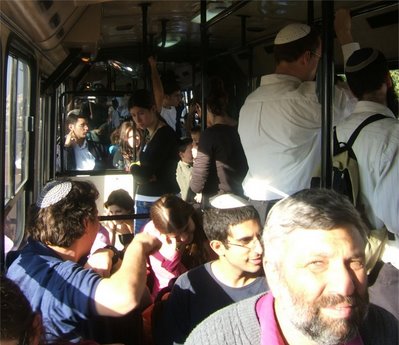
Sasha on the bus to Gilo
At Gilo, we disembarked and found ourselves on the sidewalk. Across the street, a row of the larger, inter-city busses lined up to scoop up visitors and haul them out to Hebron.
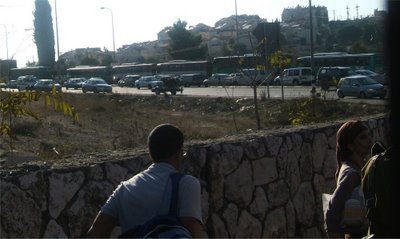 Disembarking from the local bus, heading for the inter-city busses.
Disembarking from the local bus, heading for the inter-city busses.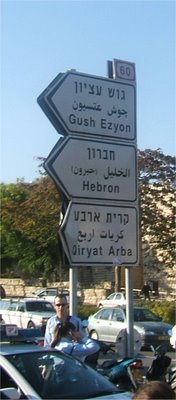
The sign for route 60, through the Judean hills to Hebron.

Travellers disembarking from the local busses streamed across the road, causing a traffic nightmare.
Once we had crammed ourselves onto the bus, we were on our way down route 60. The drive would take us past Beit Lechem (Bethlehem), the Gush Etzion settlement block, to the Jewish suburbs of Hebron.

Route shown in purple.
Driving down route 60, we passed by the outskirts of Beit Lechem, once majority Christian, but today almost entirely Muslim. The Tomb of Rachel, the only one of the biblical Jewish forefathers and foremothers not buried in the cave of the Machpelah, once sat in a field outside Beit Lechem. Today, the tomb has been encircled in the city's outskirts. The government built the wall with a narrow penetrating inside the city to encirclce the tomb to allow safe access for Jews.
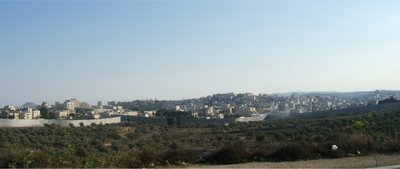
The wall around Beit Lechem. Note the loop in the center, where the wall surrounds the tomb of Rachel.

The Wall around Beit Lechem
Continuing south, we passed around Beit Lechem, through the tunnel, and out to the Gush Etzion settlement block. The settlements were rebuilt on the ruins of Jewish communities destroyed by the Jordanian legion in their 1948 invasion of Israel. Today, the population in the rebuilt towns and villages is booming, in what used to be an agricultural area but is today fast becoming a major suburb of Jerusalem.

The blue on the map above is Gush Etzion
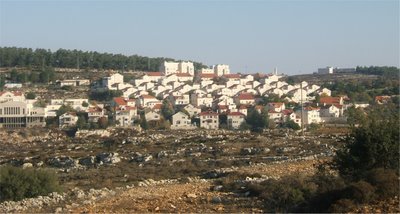 Efrat
Efrat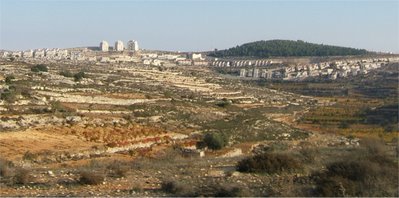 More Efrat
More EfratAfter passing through "The Gush," as it's called, the landscape becomes more open for a time. As fall settles in, the colors of the vinyards and orchards have been turning to autumn red and gold.

Vineyards

Vineyards
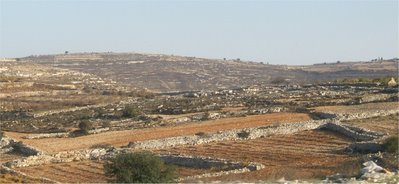
Fallow fields and farmland.
Gradually, the landscape again becomes crowded, as we approach Hebron. The bus turns west, passes through the security gate, and we have arrived. Our host family lives in Harsina, a Jewish suburb of Hebron.

The bus stop in Harsina
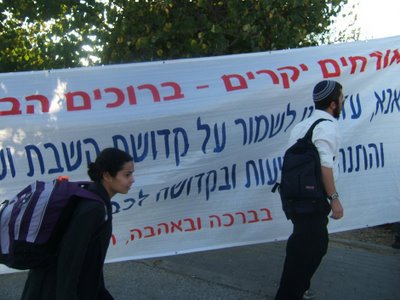
Signs welcoming visitors
Stay tuned for more!
No comments:
Post a Comment